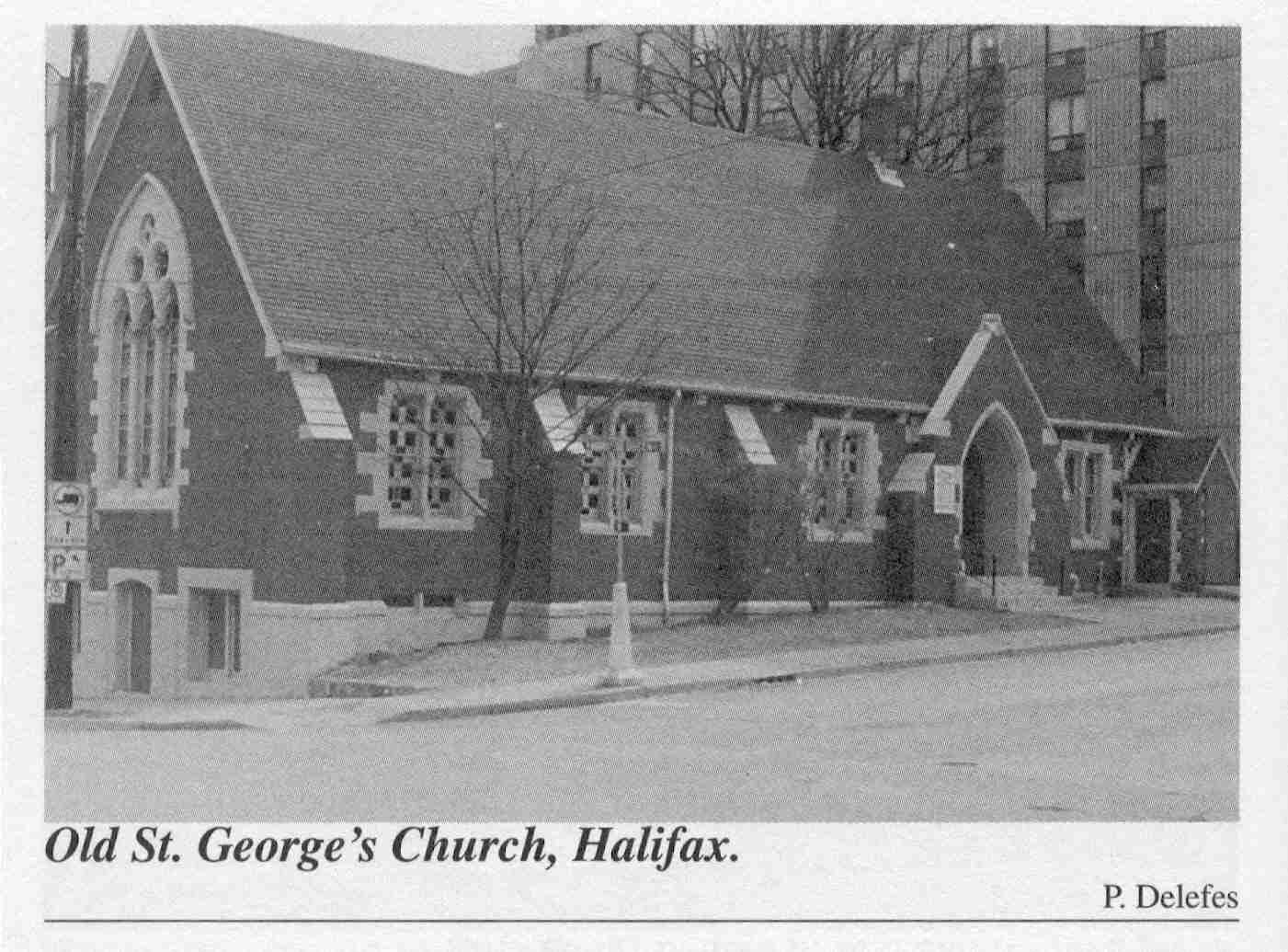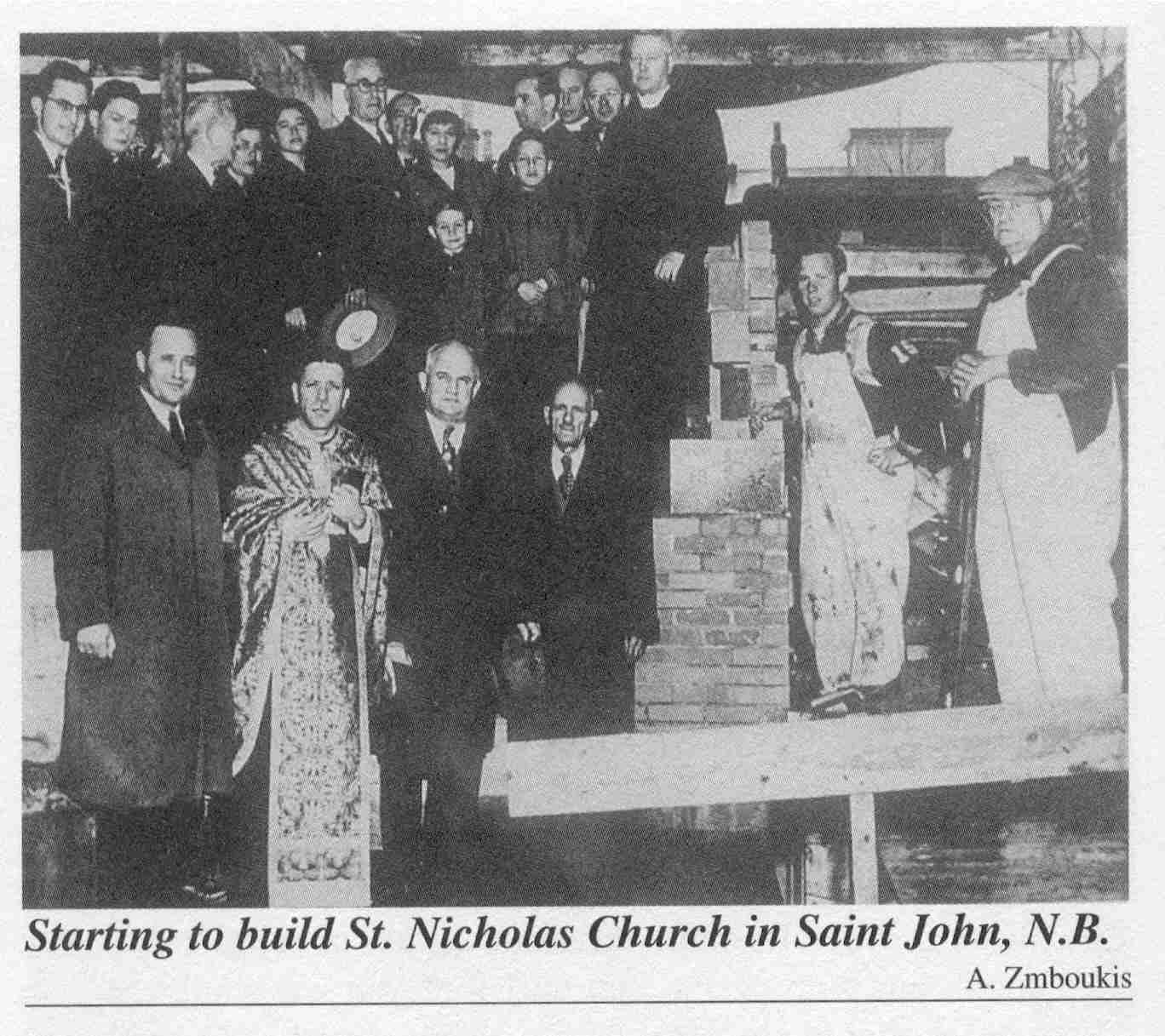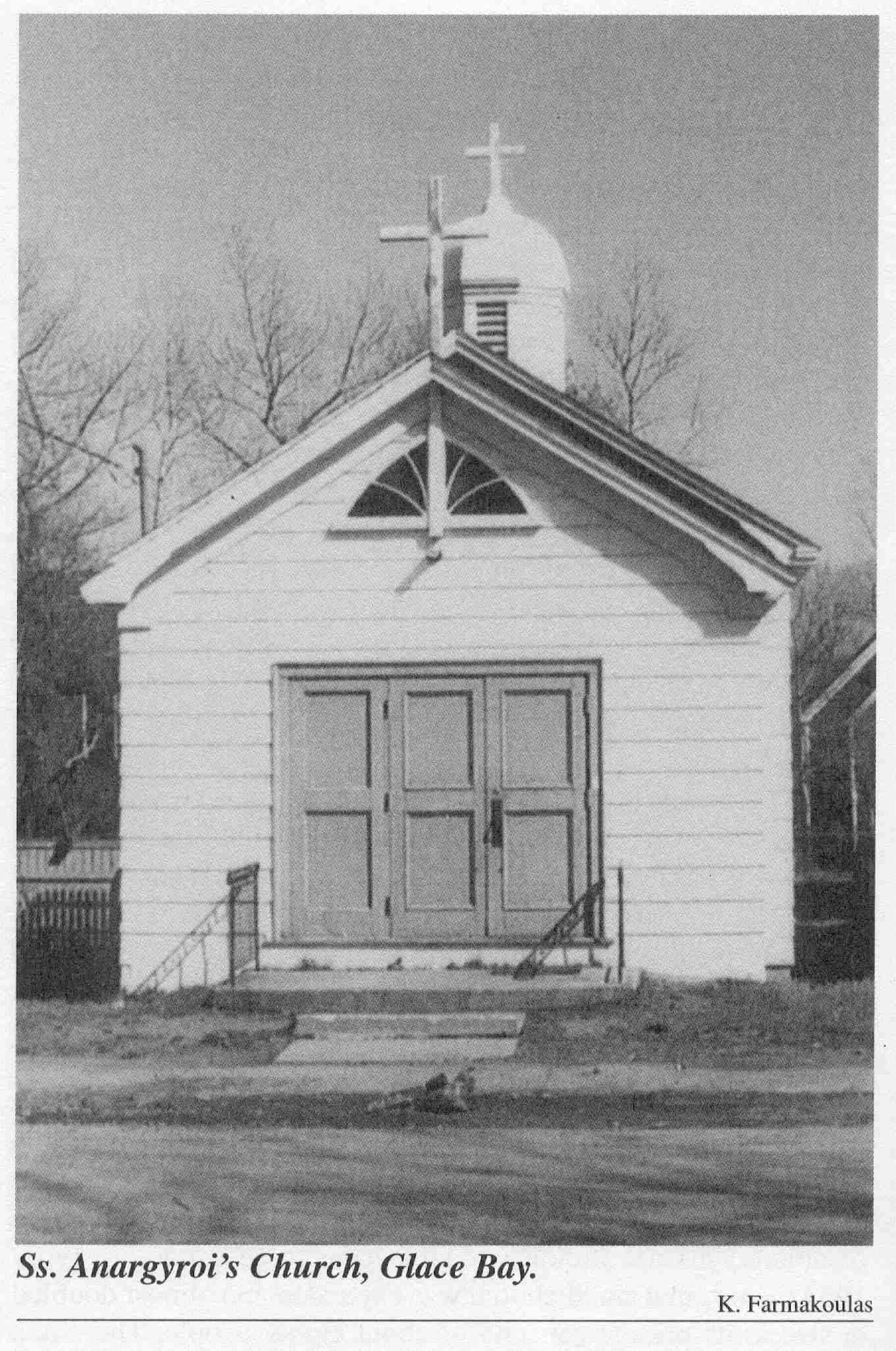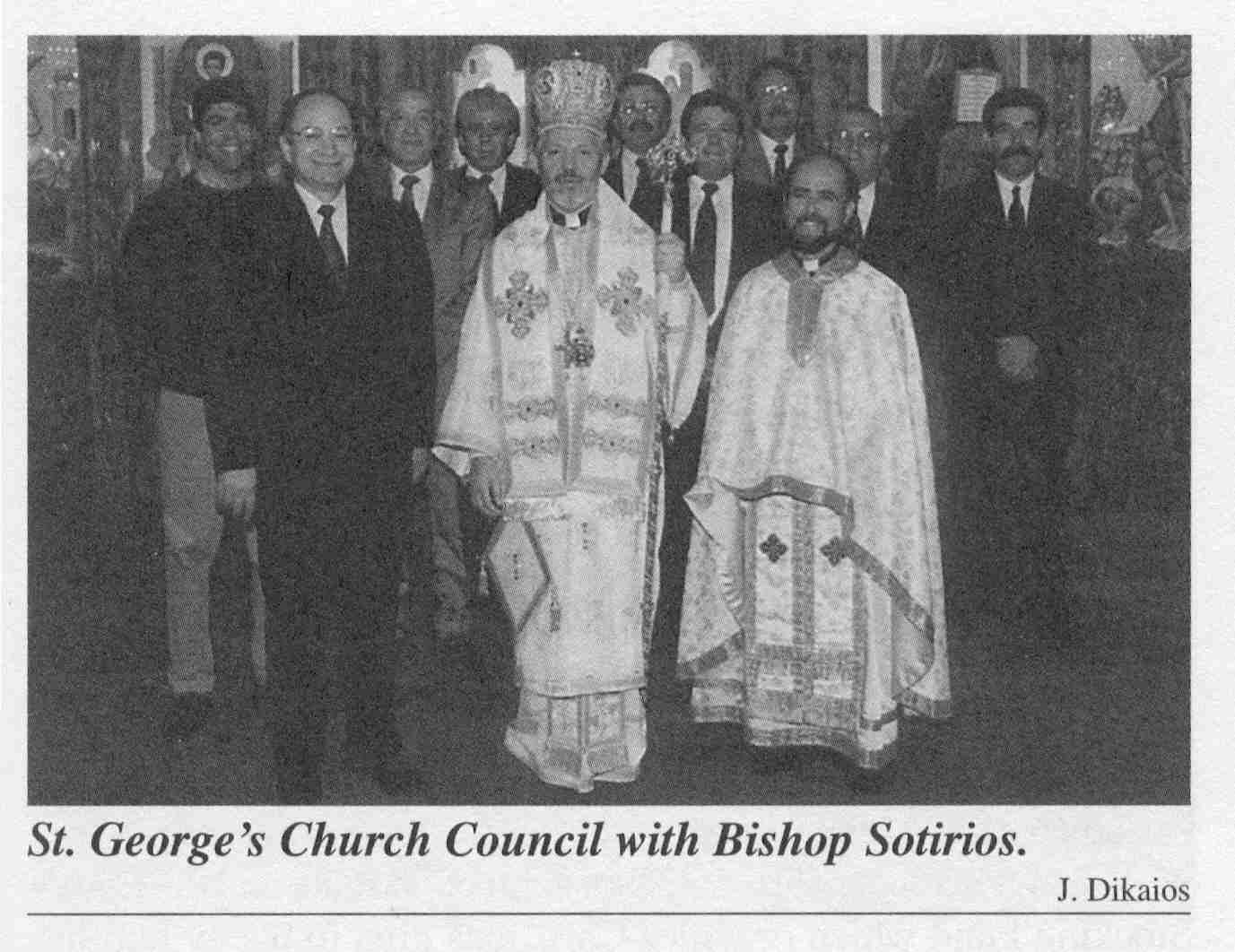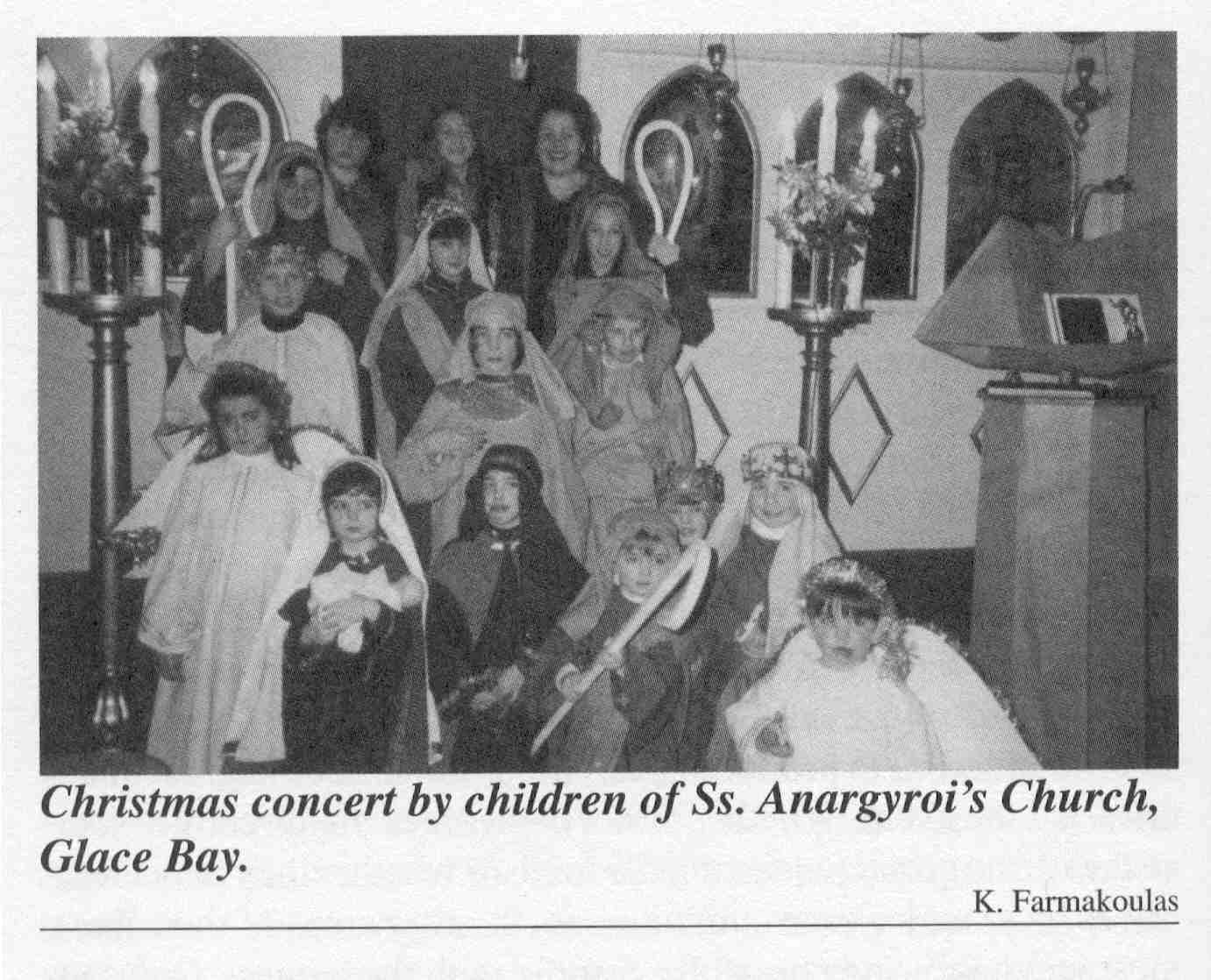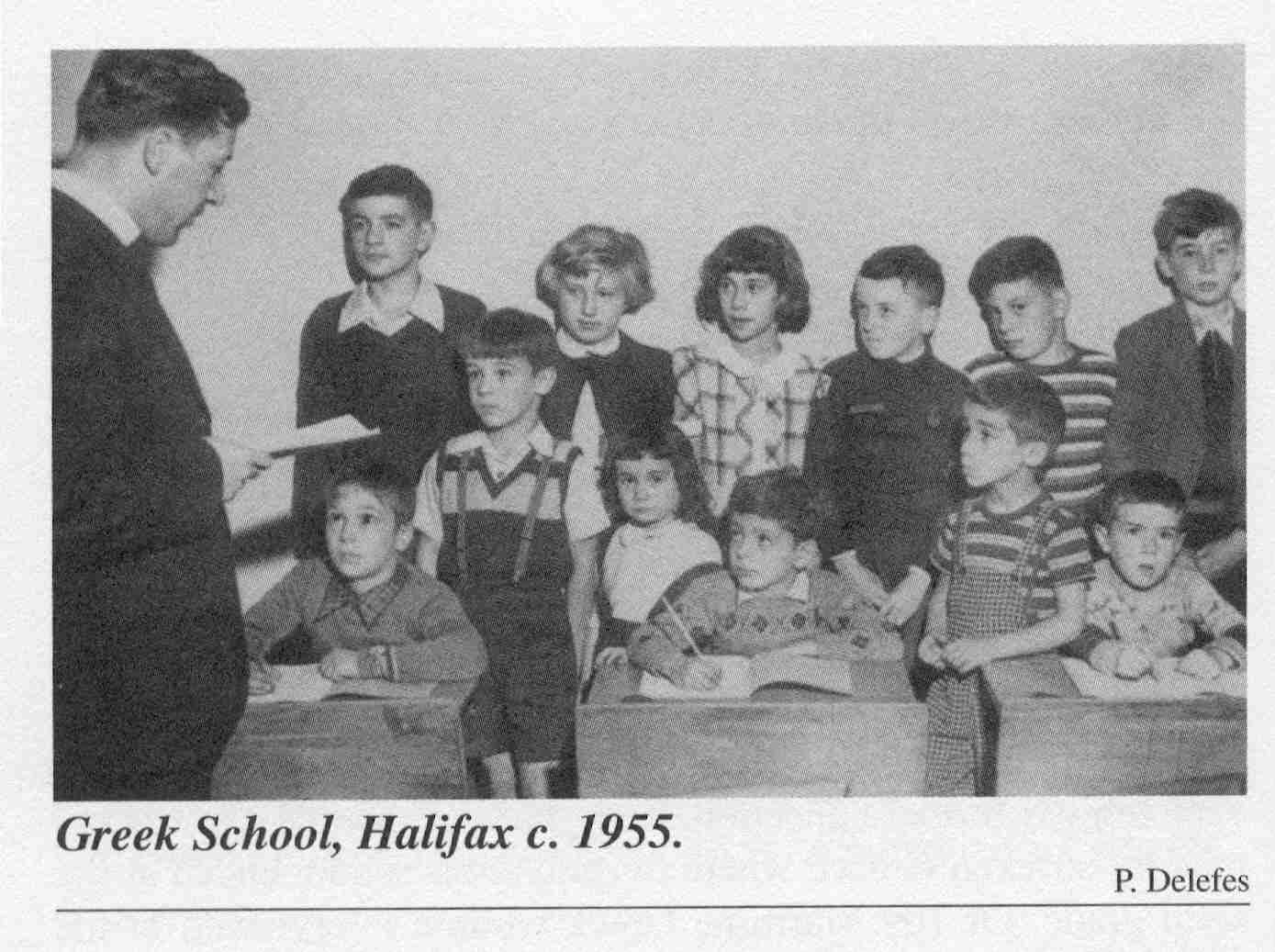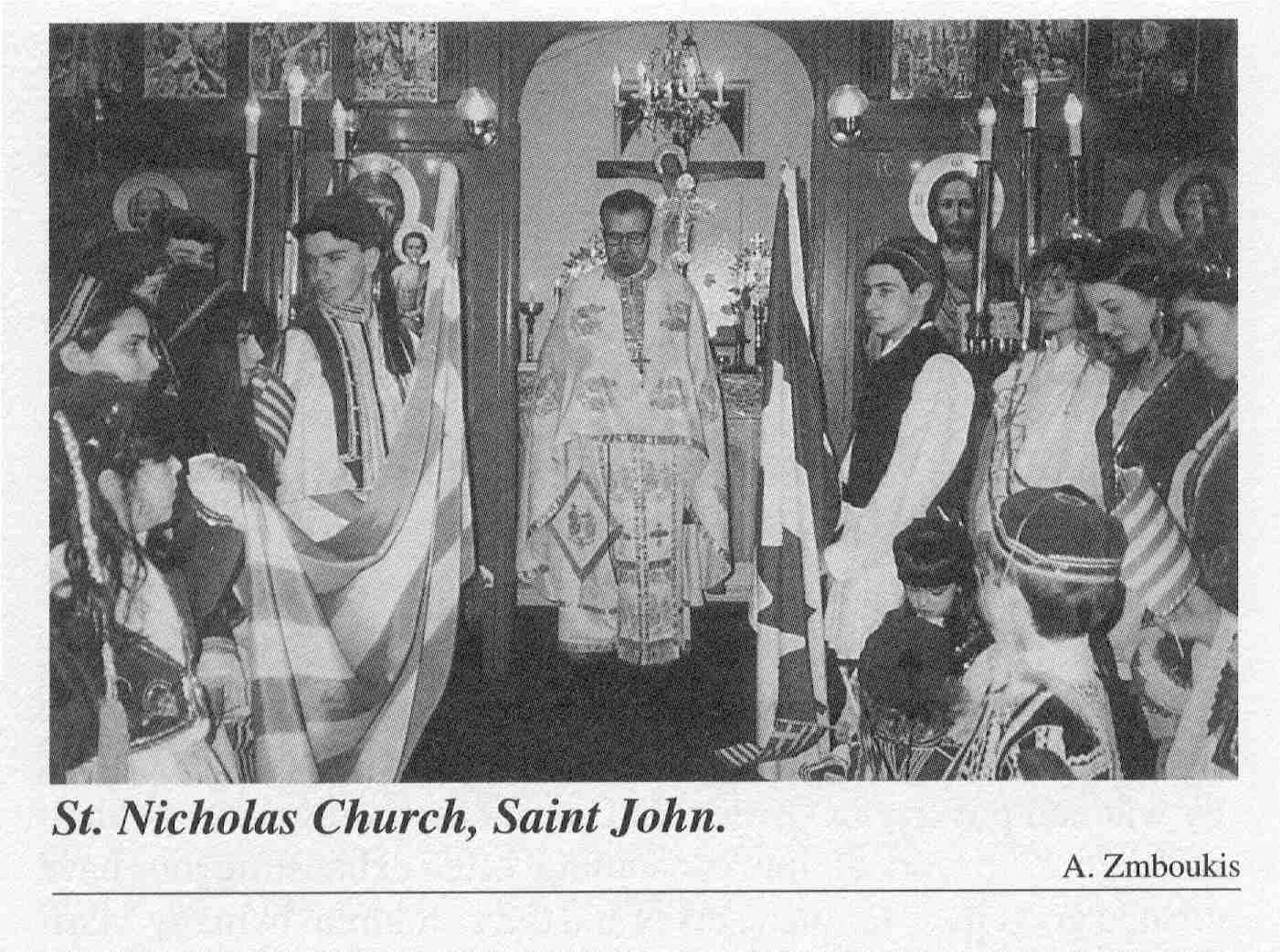III.
Church and Community in the
III.1
The Greek Orthodox Religion
Since the earliest Greek families arrived
in the Maritimes, they have shown a great desire to maintain their Greek
Orthodox religion and, where numbers allowed, to establish church buildings and
pay the salaries of Orthodox priests.
The Greek Orthodox Church of North and South America claims 1.3 million
people in the
The Greek Orthodox Church or
Archdiocese in North America is directly accountable to the ecumenical
patriarch (senior bishop) of
Under the direction of Archbishop
Sotirios the Greek Orthodox Church in
The world's Orthodox Christians
share a common doctrine which is similar to Roman Catholics and Anglicans in
their view of the sacraments, the importance of the Bible, veneration of
saints, and the authority of tradition.
They share with Roman Catholics a great veneration for Mary, Mother of
Jesus, and a dislike for the ordination of women, but, unlike Roman Catholics,
they reject the universal authority of the Pope in
One distinctive feature of Orthodox
religion is the respect given to holy pictures or icons. A fully decorated Byzantine style church glitters
with an array of icons on the iconostasis
or screen which separates the altar from the people), the dome and walls,
and in individual spots throughout the building.
The Orthodox Church service or liturgy has all the beauty, mystical
feeling, and length of the old Byzantine world from which it has come. On Good Friday (Megali Paraskevi) the epitaphios (the bier on which a
figure of Christ lies surrounded by flowers) is carried in procession around
the church - as it happens in hundreds of places in Greece itself. On Easter eve or Pascha, with the church in darkness, as the priest announces "Christos
aneste" ("Christ is risen"), he lights a candle to symbolize
the Lord's triumph over death. All
over the church the people light their own candles from the priest's candle
and from each other's, and what had previously been a dark world, now blazes
with the light of the resurrection. A
very special sense of being in close touch with the ancient roots of Christian
tradition fills everyone present at this beautiful service.
III.2
Greek Churches in the Maritime Provinces
The first Greeks arrived in Halifax
in the early period of the twentieth century.
Before the 1930s this tiny group had to bring a priest from a nearby
Greek community in the United States for religious events like weddings and
baptisms. By the early 1930s this small,
dedicated group, spurred on by a newly formed organization, the
Greek-American-Progressive Association or Order of GAPA, was able to obtain the
services of a priest, the Rev. Theodore Scartsiades. Since there was no church building, the Greek
community held services in a rented premise on the corner of Sackville and
Hollis Streets. The new priest's duties
also included regular trips to Greek families residing in Saint John, New
Brunswick and Glace Bay, Nova Scotia. On
May 2,1934 the Nova Scotia provincial legislature passed an Act of
Incorporation officially establishing the Greek Orthodox Church of Nova Scotia.
Peter Poulos, Nicholas Aliotis, Augustus Manolopoulos, James Bastas, and
Velis Lemonides were named in the Act as the trustees for the church.
On January 25,1941 the trustees of the
Greek Church in Halifax purchased St. Luke's Hall on the corner of Morris and
Queen Streets from the Anglican Diocese of Nova Scotia for $6,000.00. Members of the Greek community had been
saving their money towards this goal for years, and near the end of their fund
raising years they received a generous donation of $800.00 in the will of a
local Anglican priest, Rev. V.R. Harris.
The new building had a very suitable architectural style with ample
space for a church upstairs and a hall downstairs. Because of its location in south-end Halifax
where most of the congregation then lived, the new St.George's Greek Orthodox
Church suited the Hellenic community in Halifax very well for many years.
During World War II St. George's Church
welcomed many seamen and other armed forces personnel of the allied services
who visited or were stationed in Halifax.
The church hall was used to entertain the service men and support the
war effort. In 1943-44 the church hall
became a depot for clothing and other materials, including 15,000 pairs of
shoes, which were collected by the War Relief Commission for distribution in
Greece.
The Hellenic community in Halifax grew
rapidly in the post war years, as many Greeks left the ravages of a desperately
poor, still fractured homeland in Europe.
By the 1970s the Halifax metropolitan area had over 250 families of
Greek descent. The little St. George's
Church was filled for regular Sunday service, and on special occasions like
Christmas and Easter members of the congregation had to stand in the aisles,
the hallway, downstairs, or even outside on the Queen Street sidewalk. Then in December 1974 the Halifax Greek
community succeeded in buying a 3.5 acre lot on the shores of the North West
Arm's Melville Cove. In May 1977 the sod
for a community centre designed by Mr. Gregory Lambros, himself a member of the
church, was turned. Until 1982 the
church building in downtown Halifax continued to serve the spiritual needs of
the community, while the new building on the Purcell's Cove Road functioned as
a social centre. Construction of a new
church building above the community centre began on the Purcell's Cove site in 1982. The church includes many traditional
Byzantine features, especially a large fiberglass dome and a full array of
beautifully painted icons completed in 1999.
The new St. George's was consecrated by Bishop Sotirios in May
1985. At the opening church service
municipal, provincial, and federal politicians, along with people from outside
and inside the Greek community gathered together in celebration. As a mark of support for the initiative and
hard work of the Nova Scotia Greek community the federal and provincial
governments had given substantial sums of money to the new church's
construction. Of course, the Greek
people of the province bore the heaviest part of the financial load themselves. In spite of some regret on the part of the
congregation, the small, older St. George's building downtown was sold.
Since 1952 the Greek community on Cape
Breton Island has had their own church on Marconi St. in Glace Bay dedicated to
the Saints Anargyroi. The Saints
Anargyroi were two doctors named Cosmas and Damian who were well known for
their healing powers which they gave freely without charge. The church name Anargyroi thus means the Saints
"who have no money". Because
the small Greek community on Cape Breton Island cannot afford to maintain a full-time
priest, the Greek priest who is based in Halifax visits the community seven or
eight times each year for church services and other ministerial duties. July 1, Canada Day, is also the feast day for
Saints Cosmas and Damian. This is one
occasion when the Greek priest from Halifax always makes a special effort to be
with the parishioners of Ss. Anargyroi’s in Glace
Bay.
The decision to build a Greek Orthodox
Church on Cape Breton took years of planning.
It was Mr. George Markadonis, more than any
other individual, who helped the project begin by donating a piece of his own
land in Glace Bay for a Greek Orthodox church. After Mr. Markadonis’
death in 1947 the whole Greek Canadian community in Cape Breton worked together
to raise funds. In 1962-1963 the original small church was expanded and almost
doubled in size to its present capacity of about eighty people. There is a story that when the original Ss. Anargyroi’s Church was being built, in line with Greek
tradition, a rooster was killed on the corner of the foundation in order to
bring good luck and to add strength to the workers. To remember the work and
dedication of George Markadonis, his picture was hung in the basement hall of
the church.
Today Ss. Anargyroi’s
congregation is small with only about thirty families. Simply, sadly, most
young Greeks in Cape Breton, like their non-Greek friends, have had to leave
the Island for economic reasons. In
spite of the low numbers in the congregation a Sunday school meets every week
at Ss. Anargyroi’s where the children learn the
elements of Orthodoxy, some Greek language, as well as traditional poems and
history. The children’s Christmas concerts are said to be a delight for anyone
lucky enough to be present. Strong
family ties between Greek Canadians in Cape Breton and those in the Halifax
area mean that parishioners of Ss. Anargyroi’s often
visit in Halifax and take part in the life of St. George’s there. Many of the
members of Ss. Anargyroi’s gave generously toward the
building of St. George’s. Mrs. Katherine Farmakoulas, the long-time president
of the Church Council at Ss. Anargyroi’s says: “The church life is a very important part of
the identity of all Greek Canadians in Cape Breton. Our culture and our religion are very
connected, but without the church I feel that we would lose an important part
of our identity. Although our church in Cape Breton is small, it’s still like
home to all of us.”
St. Nicholas Greek Orthodox Church on
Dorchester Street in Saint John, New Brunswick has about eighty families with
approximately 250 parishioners, some of whom regularly travel from the cities
of Fredericton and Moncton to attend church services
and church activities in Saint John. The
Church was built in 1952, and has a full-time priest. In spite of being a small
community, the church is fully self supporting, able to finance the costs for
the church building, the priest’s stipend and house, and the various church
activities. The Archbishop publicly praised the people of St. Nicholas for all
their initiative and success as a community.
Recently the Church Council at St. Nicholas decided to improve the
building’s facilities, and to try and increase the active membership. All the
people are pleased to welcome five newly baptized babies to their church
family.
St. Nicholas Church Council has
members on it from all three principal New Brunswick cities. The Council holds at least two community
gatherings or parties each year. Like
other Greek populations all across Canada, March 25 and October 28 are always
remembered with special celebrations.
Mr. Andreas Zmboukis, the current president of
the Council says: “We were brought up to hate the Turks, but we don’t do the
same to our kids. We’re trying to pass on our history and our struggles to our
children. Our community also marks November 11, Remembrance Day, like the rest
of Canada. We celebrate Name Days, such as St. Andrew’s Day on November 30 and
St. Nicholas’ Day on December 6.” The
Council has a Youth Committee, but no youth groups have yet been formed. At a recent Christmas party sponsored by the
Council presents were given to forty children aging from two to fifteen.
Although their community is small, St.
Nicholas Church also maintains a Sunday school after church on Sunday mornings,
and a Greek school with classes meeting twice weekly. The parish priest is the
Greek schoolteacher. Students attending the Greek school are not only the
children of Greek parents, but adults who have married Greek Canadians and want
to learn the language
Father Konstandinos
Laspakis has been the priest in Saint John for eleven
months. He speaks Greek, French, and
English. A priest for thirty-five years,
he first came to Canada in 1981 as a three-month replacement for a priest friend
in Toronto. Liking the freedom of Canadian life and the friendly Canadian
people, he decided to stay. From Toronto
he moved to a small, newly organized Greek parish in Montreal, where he
remained for fourteen years. Of his
recent move to Saint John he says: “Here I have found a very good, very
generous people. I go for a walk and people smile and say: ‘Good Morning
Father’, and ‘How are you’.” Father Laspakis makes an effort to conduct the church services
almost equally in Greek and English, in order to accommodate both the older,
fluent Greek speakers, and the younger parishioners whose Greek is weaker, or
in some cases, non existent. One female
parishioner has a special episcopal blessing to go
behind the iconostasis and assist the priest in preparing the altar for the
holy services. When Father Laspakis was asked, if
there are problems when a parishioner marries a non-Orthodox, non-Greek
speaker, he said: “No, they are all Christians.
God is love.” It is clear from speaking to members of the Greek
community in Saint John that many people have married non-Orthodox Christians,
particularly Roman Catholics. In such
marriages the couple often attends both churches and celebrates special feasts
like Easter with both Greek and non-Greek traditions. All the people concerned seem comfortable
with those arrangements.
Many
people of Greek background in Nova Scotia and New Brunswick also look to the
church to foster a Hellenic identity and, where distance allows, to be a centre
for at least part of their social life.
People of Greek descent in Nova Scotia outside the Halifax area gave
generously to the building fund for the new St. George's Church, and they
continue to support it financially, though they may rarely visit Halifax. It is not unusual for the whole Greek
community in an area to be invited to the wedding of a young couple in the
Greek Church. A typical reception, which
includes a sumptuous Greek meal and dancing, follows in the social centre below
the Church. Greek festivals and dances do
not only raise money, but they also provide a place where the whole community
can come together and participate in the familiar ways of the Hellenic
homeland. This combination of the church
and the social life of the community is not something which has come to this
country from Greece. In Greece the
church exists to maintain the Christian liturgies or church services, and to
provide the people with the familiar rites for birth, marriage, and death, but
it generally stands apart from their social world. In other, large North American cities where
many Greeks live, there is a growing divergence between Greek church and Greek
community, and an individual is not necessarily excluded from the life of the
Greek community, if s(he) does not have some attachment to the church. For many individuals in Nova Scotia and New
Brunswick the Greek Church and Greek community are essentially one.
III.3
Organizations - Church and Community
In the Greek communities across
North America we find groups of people working together in organizations both
closely identified with, and sometimes independent from the Greek church. The chief organizations associated with the
Greek Orthodox Church are the Church Council, the Ladies' Philoptochos, the Sunday
school, and GOYA or Greek Orthodox Youth of America.
In Halifax the nine members of the
Council who are elected annually supervise all church activities in partnership
with the parish priest. The Council also
initiates social events such as annual dances on New Year's Eve and just before
the beginning of Lent. Over the years
much of the attention of the Halifax Council has had to be directed towards
fund raising, first to maintain the older, smaller St. George's, and then to
complete the new building. During Mr. Charles Tsuluhas' long presidency in the
1970s land was purchased for the new church and the community centre was
opened. Mrs. Lena Blitziotis was the
first female president of the Council (1988).
She remembers her term as president of the Council particularly for the
extensive renovations done that year in the community centre and for her work
as head of the Sunday school.
Where numbers allow, each Greek
Church tries to maintain a Sunday school for the children. In Halifax St. George's Sunday school has
about thirty-five children, many of them between the ages of three and six.
While it is a joy to teach their religion to the little ones, the teachers at
St. George's expressed some concerns. One teacher said: "It is not a
problem of money, but there are not enough materials for teaching our religion
to very young children who are used to Canadian ways and a Canadian style of
education. We need books which are in
simple language, so the young children can understand what we are talking about
in class. We also need to be more creative in our teaching."
In origin the Ladies' Philoptochos
("Friends of the Poor") Society is an organization to aid needy Greek
immigrants and their families. After its
founding in New York about 1902 the Philoptochos was
reorganized in the 1930s. In addition,
since its early days in both the United States and Canada, the Society also has
been involved in preserving the faith and ritual, educating the young, and in
fund raising. In Nova Scotia the Halifax
based Philoptochos which is named in honor of St. Aikaterini
(St. Catherine) has about forty-five members and an executive of nine. It is a major fundraiser for St. George's
through activities such as support for the annual Greek Festival, and by
regular bake sales. However, the Philoptochos is equally active in a whole
range of volunteer activities for church and local charities. The Philoptochos members provide coffee every
Sunday after church as well as at funerals and Mnemosyna (Memorial) services. Their charity work outside the Greek
community includes help to the Heart and Stroke Foundation, the Disability
Foundation, the Children's Hospital, Bryony House, Phoenix House, Hope Cottage
and the Metro Food Bank.
St. Nicholas Church in Saint John has
an active Philoptochos Society with about fifteen
members. The president, Mrs. Voula Likourgiotis, reported that
many other women help out when the Philoptochos holds
an event, and the Greek restaurants often donate food. Their Society raises
money through bake sales, celebration for Boxing Day, Easter, and various
saints’ days. Most of their money goes
to support St. Nicholas Church, but some is also sent to the national Philoptochos for international emergencies such as
earthquakes and other disasters. Philoptochos members
also support local charities such as the Saint John Food Bank and the Empty
Stocking Fund which provides Christmas gifts to needy families in the
metropolitan area.
According to a recent president, Peter
Tsuluhas, (son of former Council president Charles Tsuluhas)
the Halifax GOYA has about thirty members among the young people in grades 7 to
12. This group has close ties both to
the parish priest and the council. As
Peter Tsuluhas puts it: "GOYA
doesn't exist in Greece. They don't have
to work at being Greek. We here in
Halifax do have to work at it. GOYA
helps hold us together." GOYA is so
strong in Halifax that it now has divided into two groups according to
age. The young people of GOYA organize
many social events. Dances are a great
favorite, and are viewed as a way to raise money to help their church and
various local charities. An annual trip outside the province is a new feature
of GOYA life for the Halifax group. When the young people leave GOYA after high
school, many of them will go on to the newly reactivated Hellenic Student
Association which exists for the university student population of Metro.
The Hellenic Student Association has
about twenty to twenty-five members who come from Dalhousie, DalTech, Saint Mary's, and Mount Saint Vincent Universities
in Halifax. This organization is an
opportunity for Greek Canadian students to meet and share common interests. The
Hellenic Student Association gets involved in local community projects such as
the donation of blood for medical purposes.
They hold frequent dances, which are both social events and
fundraisers. Recently they donated the
profits from these dances to St. George's Church to help toward the costs of
the icons.
Because Greek dance is one of the
best-known, most colorful aspects of Greek life, and because it is so popular
with the Greek young people in Halifax, St.George's Church recently formed a
Greek Dance Club under the direction of Theofano Tsirigotis and other teachers. Children learn to do the traditional dances
from many parts of Greece. They learn, for example, the tsamikos, which was first danced by the Kleftes or Greek
Revolutionary Warriors who fought against the Turkish rulers in Greece. This dance is usually done in a circular
fashion with the hands joined. It is led
by each man in turn who, holding a handkerchief or scarf, kicks high in the air
and slaps his shoes as he expresses the dancers' joint wish to fly away from
the earth. Only girls dance the sperveri which
comes from the island of Rhodes, and is performed the night before a young
couple are to be married. The dance
takes its name from the canopy hanging over the bridal bed. In the dance the girls cross their arms,
moving in and out, as they pretend to encircle the new marriage bed. The
children in the Halifax dance group perform at nearly all Greek community
functions, and are a particular highlight at the annual Greek Festival. Because
of the popularity of Greek dance, and because they wanted more opportunities to
socialize with their own age group, some young Halifax Greek women from the
ages of sixteen to twenty-six recently asked to form their own Greek dance
class. They, too, are now asked to dance
at community functions.
Individual adults in the Greek
community can join two organizations, which stand outside the direction of the
Greek Church. Those organizations are
AHEPA (American Hellenic Educational Progressive Association) for men, and the
Daughters of Penelope for women. AHEPA
began in 1922 in Atlanta, Georgia, as a fraternal association with some Masonic
influences for Greek businessmen. This
organization was first formed to fight discrimination and prejudice against
immigrants, but later concerned itself more and more with social, educational,
and benevolent activities. The first
Canadian branch opened in Toronto in 1928.
AHEPA is committed to Greek identity in a North American context with
English as its official language. In
Canada AHEPA strives to promote two cultures, Canadian and Greek, and it
encourages its members to be active participants in the life of their local
communities. Thus the Nova Scotia branch
of AHEPA raises money for St. George’s in Halifax, gives scholarships to Greek
students who are graduating from high school and going on to university, and
participates in local community projects.
The Daughters of Penelope began in the U.S. as an auxiliary of AHEPA in
some of its functions, but at other times the members act on their own
initiative. In 1999 the Halifax chapter
of the Daughters of Penelope announced a $500 scholarship for a young woman
graduating from high school who wants to pursue post-secondary education.

